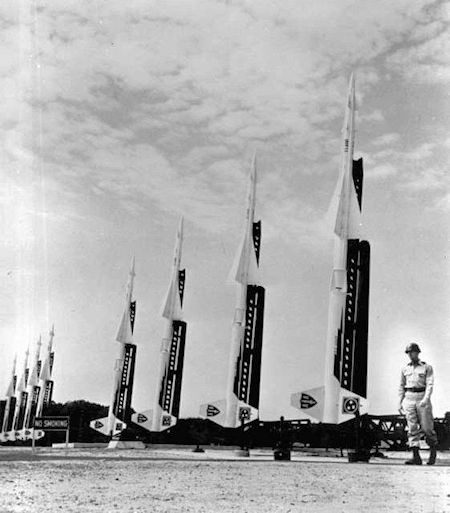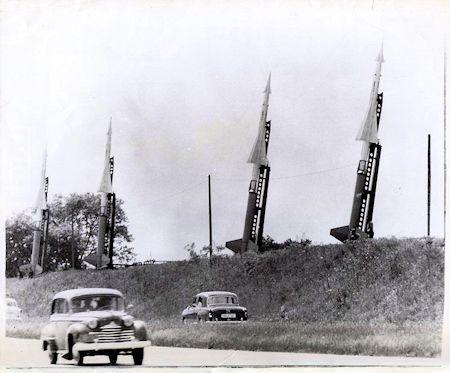
Renwal 1/32 Nike Ajax
| KIT #: | 7815 |
| PRICE: | $22.95 SRP |
| DECALS: | options |
| REVIEWER: | Scott Van Aken |
| NOTES: | 2013 Reissue |

| HISTORY |
The United States Army's Nike Ajax was the world's first operational surface to air missile (SAM), entering service in 1954. Nike Ajax was designed to attack conventional bomber aircraft flying at high subsonic speeds and altitudes above 50,000 feet (15 km). Ajax was initially deployed in the US to provide defense against Soviet bomber attacks, and was later deployed overseas to protect US bases, as well as being sold to various allied forces. Some examples remained in use until the 1970s. Ajax was given the identifiers SAM-A-7 (Surface-to-air, Army, design 7), and then MIM-3 (Mobile Interceptor Missile, design 3) in 1962.
Technological development during the 1950s quickly rendered the Ajax obsolete. It was unable to defend against more capable bombers or multiple targets in formation, and had relatively short range. Even while Ajax was being deployed, these concerns led to the contracts for the greatly improved MIM-14 Nike Hercules, which began deployment in 1959. As Hercules developed, the threat moved from bombers to ICBMs, and the LIM-49 Nike Zeus anti-ballistic missile project started to address these. All of the Nike projects were led by Bell Labs, due to their early work in radar guidance systems during World War II.
Part of the Nike Ajax development program designed a new solid fuel rocket motor used for the missile's booster. This had originally been designed for the US Navy's missiles, and was enlarged for the Nike efforts. The rocket was so useful that it found numerous applications outside the military world as the Ajax missiles were decommissioned in the 1960s. Many sounding rockets used the booster as their first or second stage, and many of those used "Nike" in their name
| THE KIT |
 I
could be wrong, but I believe this kit was initially released in the early
1960s. Renwall was always well known for producing what were considered quality
kits that were a notch above the rest and looking at these parts, I have to say
that they did an excellent job of molding the kit. The parts do have some flash
and are typical of the time when ejector pin marks were not a big deal, but
nothing major.
I
could be wrong, but I believe this kit was initially released in the early
1960s. Renwall was always well known for producing what were considered quality
kits that were a notch above the rest and looking at these parts, I have to say
that they did an excellent job of molding the kit. The parts do have some flash
and are typical of the time when ejector pin marks were not a big deal, but
nothing major.
I was particularly surprised at how nicely the three figures are molded. Unlike the box art, they are not running for shelter. There is a soldier on guard duty, one with his hands on his hips and another kneeling down as if working on something.
The missile itself is molded in white and typically, a few parts had departed the sprues. The nose fins and main rudders are supposed to be able to be moved, which will make taking care of the inevitable seam a lot easire. Like the real missile, it is divided into a booster section and forward missile.
The rest of the kit is for the launch framework. This will end up being somewhat large and like was expected, the launch rail itself can be raised or lowered via a plastic piston.
 Instructions
are pretty t
Instructions
are pretty t ypical
of modern Revell USA instructions with a list of generic colors, a full parts
list (but no diagram) and painting information provided throughout the build
sequence. For years I thought that the markings for this kit, which are pretty
gaudy, were something that was made up. However, I found a photo of all
white missiles with the large badges and the lightning bol
ypical
of modern Revell USA instructions with a list of generic colors, a full parts
list (but no diagram) and painting information provided throughout the build
sequence. For years I thought that the markings for this kit, which are pretty
gaudy, were something that was made up. However, I found a photo of all
white missiles with the large badges and the lightning bol t
on them. Whether this was a publicity photo one time deal or not, it did exist.
I also discovered that there were other coloring options for the missile, from
overall olive drab to a white warhead section and olive drab booster and other
variations. It seems that many operational missiles simply had a 'last three'
serial spray painted on the fin and booster body. So you don't have to do the
kit markings, but for the overall OD version, you'll have to find some white
'U.S. Army' markings for the warhead section.
t
on them. Whether this was a publicity photo one time deal or not, it did exist.
I also discovered that there were other coloring options for the missile, from
overall olive drab to a white warhead section and olive drab booster and other
variations. It seems that many operational missiles simply had a 'last three'
serial spray painted on the fin and booster body. So you don't have to do the
kit markings, but for the overall OD version, you'll have to find some white
'U.S. Army' markings for the warhead section.
| CONCLUSIONS |
I know that a lot of folks have been awaiting this one and I am one of them. It will not only stir up some nostalgia, but actually looks as if it will make into a very nice model.
| REFERENCES |
http://en.wikipedia.org/wiki/Nike_Ajax
July 2013
Thanks to me for getting this one so you could take a trip down memory lane.
If you would like your product reviewed fairly and fairly quickly, please contact the editor or see other details in the Note to Contributors.